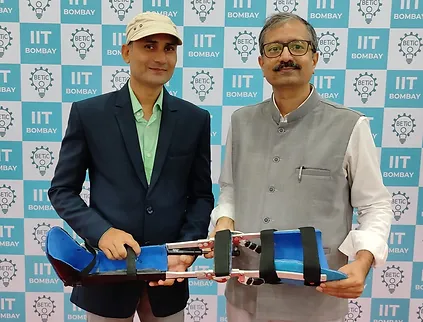A Stance Controlled Knee-Ankle Foot Orthosis
The stance-controlled knee-ankle foot orthosis (SCKAFO) is an innovative medical device designed to improve the mobility of individuals with weakened knee joints, often due to conditions like poliomyelitis. This orthosis aims to provide a more natural gait by addressing the limitations of existing knee-ankle foot orthoses, usually resulting in an unnatural and tiring walking pattern. The device features a sophisticated mechanical system that locks and unlocks the knee joint based on the pressure exerted by the heel during the gait cycle, eliminating the need for bulky and expensive electronic components. This mechanism eliminates the need for manual locking and unlocking mechanisms, reduces unnatural gait patterns, and allows for activities such as squatting while offering fail-safe features to prevent unintended locking. The SCKAFO's unique design reduces user fatigue and makes the device more accessible and affordable.

Existing KAFOs typically lock the knee joint in both the stance and swing phases of walking, leading to an unnatural gait pattern often described as circumduction. This circumduction increases fatigue for the user due to the extra energy expenditure required to compensate for the locked knee. Additionally, current solutions, including electronic and electric versions, are often prohibitively expensive and bulky, limiting their accessibility and practicality for many of the population. This device seeks to overcome these limitations by providing a stance-control KAFO (SCKAFO) that allows for a more natural gait, reducing fatigue and improving overall user experience while remaining affordable and less cumbersome.
- Natural Gait: By locking the knee during stance and unlocking during swing, the orthosis allows for a more natural walking pattern, reducing user fatigue and circumduction.
- Non-Electronic: The mechanical nature of the device eliminates the need for batteries and electronic components, making it lighter, more reliable, and affordable.
- Cost-Effective: Designed to be affordable and accessible, it addresses the financial barrier posed by high-cost electronic orthoses.
- User Comfort: The orthosis provides full uninhibited squatting, improving comfort and usability in various activities.
- Weight-Activated Locking Mechanism: Features a unique locking mechanism triggered by the user's body weight during the stance phase of walking.
- Heel-Strike Actuation: The locking mechanism is specifically designed to engage when the user's heel strikes the ground, mimicking the natural biomechanics of walking and enhancing gait stability.
- Automatic Swing-Phase Unlocking: The locking mechanism automatically disengages as the user transitions into the swing phase of gait, which allows a more natural and less restrictive range of motion.
- Pawl and Ratchet System: The specific geometry of the pawl and ratchet ensures unidirectional locking, preventing unintended knee bending during stance.
- Offset Actuator Assembly: The offset corrects misalignments in the user's leg, gently guiding the knee into a more biomechanically sound position during stance.
- Integrated Tension Spring (Fail-Safe): A tension spring is integrated to keep the pawl disengaged, preventing the knee from locking and potentially causing injury.
- Squatting Functionality: The ratchet design enables the user to achieve a full squatting position without restriction.
The stance-controlled knee-ankle-foot orthosis (KAFO) is designed to assist individuals with weak knee joints in achieving a more natural gait. It comprises four main components: a thigh assembly, a knee assembly, a shank assembly, and a foot assembly. The thigh and shank assemblies provide support for their respective leg sections, while the foot assembly includes a base plate with a heel pressure sensor. This sensor detects the wearer's weight distribution during the gait cycle. The knee assembly is the core functional unit, featuring a ratchet and pawl mechanism connected to a system of springs and levers. When the wearer's heel strikes the ground (stance phase), the heel pressure sensor activates the ratchet and pawl mechanism, effectively locking the knee joint and providing support. As the wearer's weight shifts off the heel during the swing phase, the mechanism disengages, allowing the knee to flex freely. This cyclical locking and unlocking process, driven by the wearer's weight and gait, aims to produce a smoother and more natural walking pattern.
The technology presents a cost-effective and mechanically-driven knee-ankle foot orthosis that improves mobility for individuals with weak knee joints. Unlike expensive electronic counterparts, this orthosis utilizes a unique pawl-ratchet mechanism activated by the user's body weight and heel strike. This enables a natural gait by locking the knee during the stance phase for support and automatically unlocking it during the swing phase for a smoother, less fatiguing walking experience. This innovation has the potential to significantly improve the quality of life for a vast population facing mobility challenges due to conditions like polio or knee injuries, particularly in regions with limited access to expensive medical devices. By promoting independent mobility, the technology can empower individuals to engage more fully in social and economic activities, fostering inclusivity and reducing reliance on external assistance.
The stance-controlled knee-ankle foot orthosis is primarily designed for the healthcare and medical devices industry, specifically targeting individuals with lower limb impairments like poliomyelitis, who require assistance in achieving a natural gait cycle.
